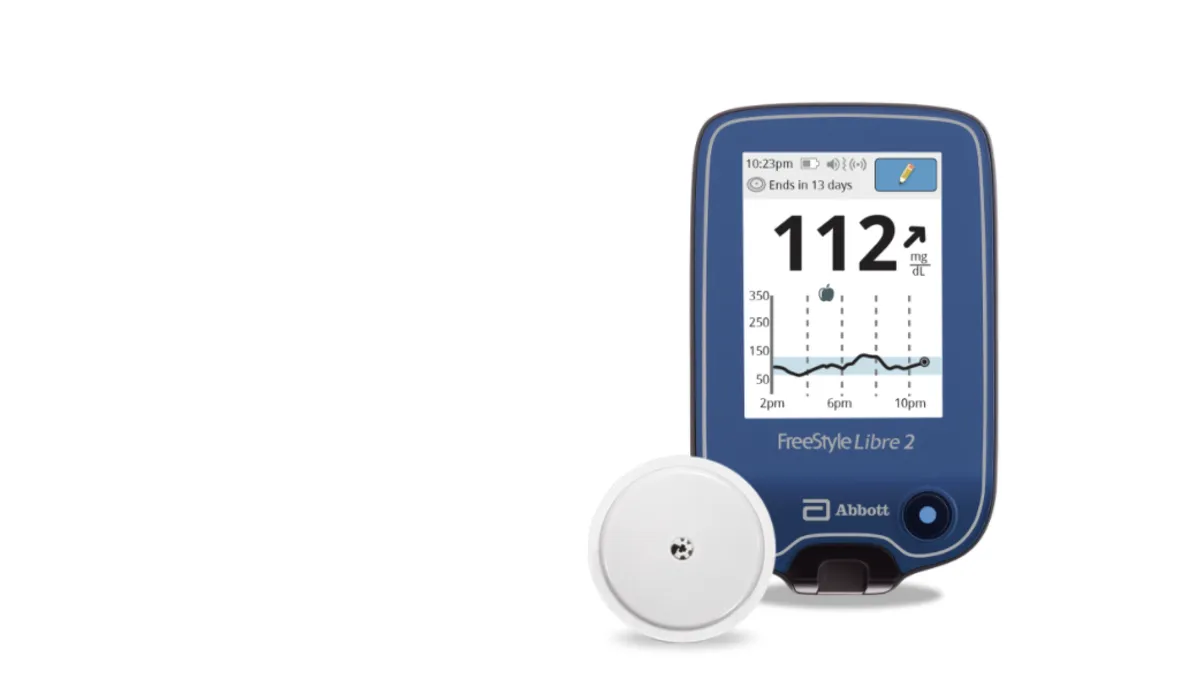Dive Brief:
-
Abbott has received FDA clearance for the latest version of its blockbuster FreeStyle Libre diabetes device as an integrated continuous glucose monitor, or iCGM, the company touted Monday. The agency cleared the 14-day-wear system to help manage diabetes in people four years of age and older.
-
The decision caps off a long process in the U.S. for Abbott, which gained a CE mark for the product over a year and a half ago. Abbott said the system will be available "in the coming weeks" through both pharmacies and durable medical equipment suppliers. The new system is being priced the same as its already available 14 day system, the company said.
-
In late-breaking abstracts shared over the weekend at the American Diabetes Association 80th Scientific Sessions, Abbott presented retrospective, observational studies that linked use of its existing FreeStyle Libre 14 day system, approved by FDA in July 2018, to reductions in hemoglobin A1c levels in patients not taking insulin. The results could support Abbott’s efforts to expand the market for the device line and, in doing so, maintain the momentum behind a device that grew around 60% in the first quarter.
Dive Insight:
FDA established the iCGM category in March 2018 with De Novo authorization of Dexcom's G6 continuous glucose monitor. The label indicates a CGM may interface with other compatible diabetes management devices, including insulin pumps, blood glucose meters, and perhaps most notably, automated insulin dosing systems.
The agency has since established similar categories for other parts of an interoperable system, including an alternate controller enabled pump, or ACE pump, and an interoperable automated glycemic controller, which is an algorithm that connects an iCGM and ACE pump for dosing purposes. Ultimately, a user may choose to combine devices from all three categories to allow for automatic insulin dosing based on blood glucose readings picked up by the CGM for more seamless, personalized daily management of diabetes.
Abbott's management team had been addressing questions about FreeStyle Libre 2's status at FDA for at least the better part of a year. On an April 2019 earnings call, execs said the submission seeking iCGM status had been filed with FDA. Three months later, management declined to speculate on approval timing. In October, CEO Robert Ford told investors, "Admittedly, it is taking longer than we expected; we are currently working through a handful of open items with the agency."
Ford again acknowledged but downplayed Libre 2's still outstanding FDA review during earnings calls in January and April this year, noting the diabetes business didn't need Libre 2 in the U.S. or an iCGM label to support meaningful growth.
Despite Abbott's aim of achieving iCGM status for Libre 2, Wall Street analysts have doubted the impact of that label on Abbott's business and on competitor Dexcom, which until now had been the lone CGM maker to boast the iCGM status for its device.
For now, Libre 2 is not authorized for use with any automated insulin dosing systems, although it still plans to pursue future integration with systems from Insulet, Tandem and Bigfoot.
The FreeStyle Libre device established diabetes care as a critical, potentially pandemic-proof growth driver for Abbott. Last year, the company’s diabetes sales increased 35.7% on an organic basis. Abbott kept up the pace in the first quarter, when organic growth in FreeStyle Libre sales of 62.5% supported a 35.6% rise in revenue across the diabetes group.
Abbott began 2020 with plans to continue growing the FreeStyle Libre user base, in part by expanding beyond the intensive insulin users that currently make up its core market.
At ADA, three of the late-breaking abstracts involving FreeStyle Libre covered use of CGM in patients not taking insulin. One retrospective study found the start of FreeStyle Libre use had a bigger effect numerically on the blood glucose levels of non-insulin-intensive patients than their counterparts on long-acting insulin. The effect of CGM use on blood glucose levels was evident after six and 12 months.
Another retrospective study also looked at the effect of FreeStyle Libre on the blood glucose levels of insulin and non-insulin-dependent patients. Both groups experienced significant declines in HbA1c blood glucose levels after starting on FreeStyle Libre. The steepest decline was seen in the non-insulin cohort.
The third study analyzed commercial claims and Medicare data to understand the effect of FreeStyle Libre use on acute diabetes events and all-cause hospitalization in Type 2 diabetics not taking bolus insulin. The analysis linked FreeStyle Libre use to reductions in both outcomes.
In a statement, Abbott argued the data indicate “people may be able to manage their glucose levels with CGM technology instead of adding insulin.” As Abbott has traditionally targeted patients who take insulin several times a day, data supporting the use of FreeStyle Libre in non-insulin patients could help open up a new piece of the market.
A fourth abstract featured data on people with Type 1 or Type 2 diabetes from Sweden’s National Diabetes Register that added to evidence Abbott’s CGM has durable effects on blood glucose levels.










